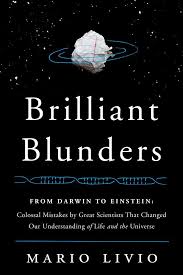March 13, 2014 – While down in Florida a good friend suggested I read Mario Livio‘s latest book, Brilliant Blunders: From Darwin to Einstein. Its subtitle is Colossal Mistakes by Great Scientists That Changed Our Understanding of Life and the Universe. I immediately chimed in saying you mean like Darwin not knowing about Mendel’s research into genetics? My friend said, “exactly.”
Livio is an astrophysicist who lives in Baltimore, Maryland, and who authors a blog on the Huffington Post. His approach to this subject focuses on five famous men from the world of science, Charles Darwin, Lord Kelvin, Linus Pauling, Fred Hoyle and Albert Einstein. It is hard to think of these pre-eminent scholars having blundered in their scientific research but that is exactly what Livio exposes and he does it in an intriguing way. First he describes in wonderful detail each man’s contribution of each to scientific advancement. Then he shows that through their own human frailty displaying hubris, laziness, stubbornness or even an overweening urge for tidiness how they stumbled down the wrong path. Eventually others would pick up the slack and correct their mistakes. Livio is a good story teller and he makes the science palatable even to those who are laymen like myself.
In the story of Darwin he talks about how the father of evolution sought a mechanism that could explain how natural selection could lead to recessive traits could suddenly reappear in descendants of plants and animals. He ended up proposing pangenesis, a hypothesis that suggested somehow an unknown force within the body instructed reproductive cells. Darwin had done experiments similar to Gregor Mendel using snapdragons, not pea plants. But he never quite figured out the formula of Mendelian heredity. If he had we have seen the science of genetics advance in leaps and bounds. Poor Gregor Mendel. His work remained obscure and little known. With Darwin’s endorsement instead of a hiatus of 55 years from when Mendel first published in 1865 to almost universal acceptance of his observational research in the 1920s, the mechanism for evolution remained a bit of a mystery. Would we have discovered DNA sooner?
Lord Kelvin who was born William Thomson is best known for his work in the field of physics where he advanced the science of thermodynamics. Kelvin invented the thermometer that bears his name. It describes a hypothetical zero temperature where an object exists in the absence of any heat energy. With all his brilliance Kelvin foundered on the subject of the age of the Earth coming up with calculations that indicated an age of no more than 100 million years. His measurements were based on false assumptions about the heat source within the Earth. That’s because he didn’t know about radioactivity and even after its discovery remained unconvinced that it could help determine the Earth’s real age. Those who followed Kelvin in refuting his hypotheses advanced our understanding of radioactive decay and gave us an accurate picture of the Earth’s real age, 4.5 billion years. Why did Kelvin stubbornly stick to his hypotheses? Livio argues it was cognitive dissonance, a sense of discomfort knowing that his theories no longer matched the reality of scientific advancement leading to denial.
Linus Pauling on the other hand is one of the outstanding minds of the 20th century when it comes to the field of chemistry. Self-taught, he won a Nobel Prize for his work on understanding the nature of chemical bonds and molecular constructs. He discovered the cause of sickle cell anemia, determined the structure of proteins and invented oxygen meters for use in submarines. But when it came to discovering the structure of DNA, Pauling’s triple helix hypothesis proved to be his brilliant blunder. When he published both James Watson and Francis Crick knew Pauling had gotten it wrong. They subsequently published a paper describing the double helix and its mechanism. Pauling missed the boat and he may have done this out of laziness. He had access to the same x-ray crystallography as Watson and Crick but chose not to look at it.
Fred Hoyle always intrigued me as young boy growing up. I remember reading a science fiction novel written by him and published in 1957 called The Black Cloud. Like his contemporary in England, John Wyndham, both wrote catastrophic fantasies that were compelling reads. Hoyle was the first to make us aware that we were composed of star stuff, that most of the elements in the periodic table came out of the nuclear interactions happening within stars. Before Hoyle astrophysicists were in a quandary trying to figure out how the elements beyond helium could form. And the mechanism for spreading these elements around the Universe was also suggested by Hoyle – supernovas. These explosions of stars ejected the heavier elements of the periodic table into interstellar space and hence planets and life became possible in our universe.
Hoyle is also associated with the field of cosmology, the science that looks at the Universe and attempts to make sense of its origin, its composition and its future. He may have even been the first to coin the term The Big Bang, describing the point in time when our Universe came into being. But Hoyle didn’t accept that cosmological model. Instead he proposed a steady state universe in which new galaxies and matter appeared out of nothing. For several decades Hoyle’s steady state universe model competed with The Big Bang until the science caught up with the hypothesis. Hoyle had gotten it wrong. Arno Penzias and Robert Wilson working on an antenna for communication satellites at the Bell Labs in New Jersey picked up background cosmic microwave radiation in the form of radio noise which led to a confirmation of The Big Bang. Hoyle stubbornly clung to his steady state theory believing that a Universe formed in an explosion and evolving into increasing disorder could not lead to the emergence of life. Evolutionary scientists soon described his theory as “Hoyle’s fallacy.”
But Hoyle wasn’t finished in proposing ideas of consequence to the scientific community. One of these is panspermia, a hypothesis for the origin of life which argues that the stuff of life can be found in interstellar space and that comets and asteroids are the messengers and carriers of life and the reason there is life on Earth today. Livio doesn’t delve into this Hoyle theory of life in the Cosmos, probably because it doesn’t fit with his brilliant blunder theme. But we still don’t know if Hoyle was right. We have discovered amino acids and complex polymers in interstellar space. We have disputed evidence that Martian microbes may have been delivered to Earth from meteorites that have been found in the Antarctic.
And finally we come to Albert Einstein, the face of modern physics, the man who gave us space-time and explained gravity in ways Isaac Newton would have appreciated. The theory of relativity was always seen as untidy to Einstein. He wanted a universal theory that explained the Universe on a cosmic scale and one that also took into consideration what was happening at the subatomic scale, the world of quantum physics.
So he invented a mathematical construct that would clean it all up called the cosmological constant. But Einstein never truly believed in this theoretical solution to explaining the geometry, composition and age of the Universe. In some respects his constant was a way to placate those scientists who believed in Hoyle’s steady state or static Universe, and not the model of The Big Bang. And the scientific community went along with him seeing the constant as a repulsive countering force to gravity which physicists knew worked well in explaining solar systems and galaxies, but really didn’t when describing the Universe.
Einstein never discovered that our Universe’s expansion was actually accelerating. This new science emerged long after his death. And Einstein never knew about dark matter and dark energy, a science that is very much part of cosmology today. His cosmological constant, what he described as a tidying up exercise, and one that he soon rejected, could have forecast these later discoveries.
From Darwin to Einstein, Livio has given us a series of biographical pictures of individuals who were subject to all our foibles, while still brilliant contributors to the advancement of human knowledge. I highly recommend his book to all my readers.

















[…] https://www.21stcentech.com/brilliant-blunders-mario-livios-book-worth-read/ […]
[…] Brilliant Blunders: From Darwin to Einstein https://www.21stcentech.com/brilliant-blunders-mario-livios-book-worth-read/ […]